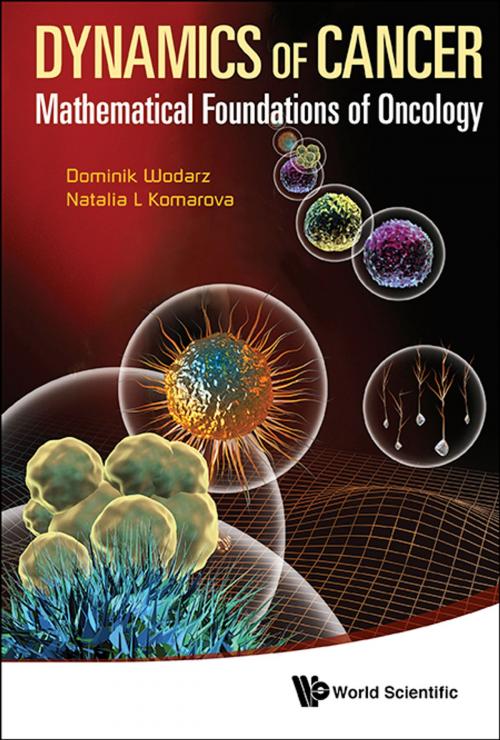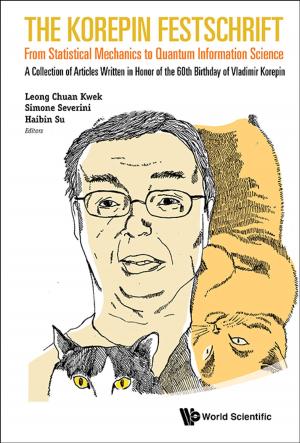Dynamics of Cancer
Mathematical Foundations of Oncology
Nonfiction, Health & Well Being, Medical, Medical Science, Biotechnology, Science & Nature, Mathematics, Applied| Author: | Dominik Wodarz, Natalia L Komarova | ISBN: | 9789814566384 |
| Publisher: | World Scientific Publishing Company | Publication: | April 24, 2014 |
| Imprint: | WSPC | Language: | English |
| Author: | Dominik Wodarz, Natalia L Komarova |
| ISBN: | 9789814566384 |
| Publisher: | World Scientific Publishing Company |
| Publication: | April 24, 2014 |
| Imprint: | WSPC |
| Language: | English |
The book aims to provide an introduction to mathematical models that describe the dynamics of tumor growth and the evolution of tumor cells. It can be used as a textbook for advanced undergraduate or graduate courses, and also serves as a reference book for researchers. The book has a strong evolutionary component and reflects the viewpoint that cancer can be understood rationally through a combination of mathematical and biological tools. It can be used both by mathematicians and biologists. Mathematically, the book starts with relatively simple ordinary differential equation models, and subsequently explores more complex stochastic and spatial models. Biologically, the book starts with explorations of the basic dynamics of tumor growth, including competitive interactions among cells, and subsequently moves on to the evolutionary dynamics of cancer cells, including scenarios of cancer initiation, progression, and treatment. The book finishes with a discussion of advanced topics, which describe how some of the mathematical concepts can be used to gain insights into a variety of questions, such as epigenetics, telomeres, gene therapy, and social interactions of cancer cells.
Contents:
-
Teaching Guide
Cancer and Somatic Evolution
Mathematical Modeling of Tumorigenesis
-
Basic Growth Dynamics and Deterministic Models:
- Single Species Growth
- Two-Species Competition Dynamics
- Competition Between Genetically Stable and Unstable Cells
- Chromosomal Instability and Tumor Growth
- Angiogenesis Inhibitors, Promoters, and Spatial Growth
-
Evolutionary Dynamics and Stochastic Models:
- Evolutionary Dynamics of Tumor Initiation Through Oncogenes: The Gain-of-Function Model
- Evolutionary Dynamics of Tumor Initiation Through Tumor-Suppressor Genes: The Loss-of-Function Model and Stochastic Tunneling
- Microsatellite and Chromosomal Instability in Sporadic and Familial Colorectal Cancers
- Evolutionary Dynamics in Hierarchical Populations
- Spatial Evolutionary Dynamics of Tumor Initiation
- Complex Tumor Dynamics in Space
- Stochastic Modeling of Cellular Growth, Treatment, and Resistance Generation
- Evolutionary Dynamics of Drug Resistance in Chronic Myeloid Leukemia
-
Advanced Topics:
- Evolutionary Dynamics of Stem-Cell Driven Tumor Growth
- Tumor Growth Kinetics and Disease Progression
- Epigenetic Changes and the Rate of DNA Methylation
- Telomeres and Cancer Protection
- Gene Therapy and Oncolytic Virus Therapy
- Immune Responses, Tumor Growth, and Therapies
- Towards Higher Complexities: Social Interactions
Readership: Researchers in mathematical biology, mathematical modeling, biology, mathematical oncology.
Key Features:
- Both a reference book for the topic, and provides material for undergraduate and graduate courses
- Tries to bridge the divide between mathematicians and biologists, which is also reflected in the backgrounds of the two authors
- Shows how mathematical concepts can be translated into experimentally and clinically useful insights
- Rooted in evolutionary biology, the book handles this very complex phenomenon in an intuitive and mathematically elegant way
- Contains problems and research projects for each topic
- 10 pages of figures in color
The book aims to provide an introduction to mathematical models that describe the dynamics of tumor growth and the evolution of tumor cells. It can be used as a textbook for advanced undergraduate or graduate courses, and also serves as a reference book for researchers. The book has a strong evolutionary component and reflects the viewpoint that cancer can be understood rationally through a combination of mathematical and biological tools. It can be used both by mathematicians and biologists. Mathematically, the book starts with relatively simple ordinary differential equation models, and subsequently explores more complex stochastic and spatial models. Biologically, the book starts with explorations of the basic dynamics of tumor growth, including competitive interactions among cells, and subsequently moves on to the evolutionary dynamics of cancer cells, including scenarios of cancer initiation, progression, and treatment. The book finishes with a discussion of advanced topics, which describe how some of the mathematical concepts can be used to gain insights into a variety of questions, such as epigenetics, telomeres, gene therapy, and social interactions of cancer cells.
Contents:
-
Teaching Guide
Cancer and Somatic Evolution
Mathematical Modeling of Tumorigenesis
-
Basic Growth Dynamics and Deterministic Models:
- Single Species Growth
- Two-Species Competition Dynamics
- Competition Between Genetically Stable and Unstable Cells
- Chromosomal Instability and Tumor Growth
- Angiogenesis Inhibitors, Promoters, and Spatial Growth
-
Evolutionary Dynamics and Stochastic Models:
- Evolutionary Dynamics of Tumor Initiation Through Oncogenes: The Gain-of-Function Model
- Evolutionary Dynamics of Tumor Initiation Through Tumor-Suppressor Genes: The Loss-of-Function Model and Stochastic Tunneling
- Microsatellite and Chromosomal Instability in Sporadic and Familial Colorectal Cancers
- Evolutionary Dynamics in Hierarchical Populations
- Spatial Evolutionary Dynamics of Tumor Initiation
- Complex Tumor Dynamics in Space
- Stochastic Modeling of Cellular Growth, Treatment, and Resistance Generation
- Evolutionary Dynamics of Drug Resistance in Chronic Myeloid Leukemia
-
Advanced Topics:
- Evolutionary Dynamics of Stem-Cell Driven Tumor Growth
- Tumor Growth Kinetics and Disease Progression
- Epigenetic Changes and the Rate of DNA Methylation
- Telomeres and Cancer Protection
- Gene Therapy and Oncolytic Virus Therapy
- Immune Responses, Tumor Growth, and Therapies
- Towards Higher Complexities: Social Interactions
Readership: Researchers in mathematical biology, mathematical modeling, biology, mathematical oncology.
Key Features:
- Both a reference book for the topic, and provides material for undergraduate and graduate courses
- Tries to bridge the divide between mathematicians and biologists, which is also reflected in the backgrounds of the two authors
- Shows how mathematical concepts can be translated into experimentally and clinically useful insights
- Rooted in evolutionary biology, the book handles this very complex phenomenon in an intuitive and mathematically elegant way
- Contains problems and research projects for each topic
- 10 pages of figures in color















